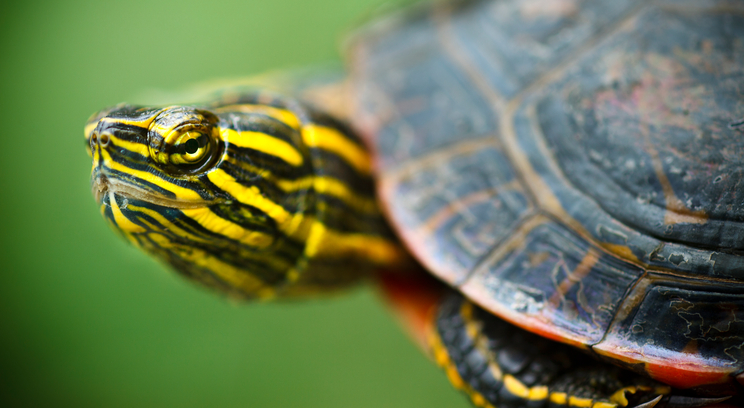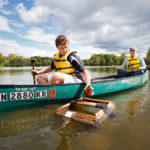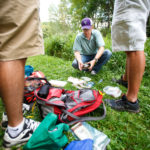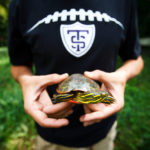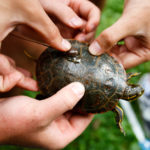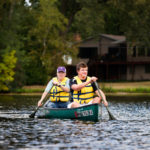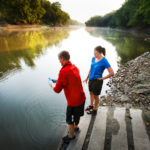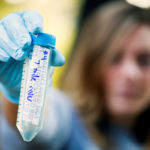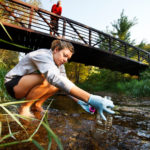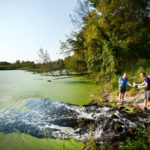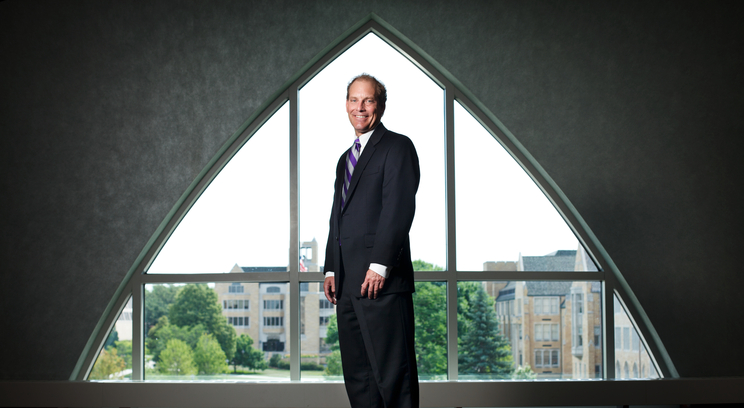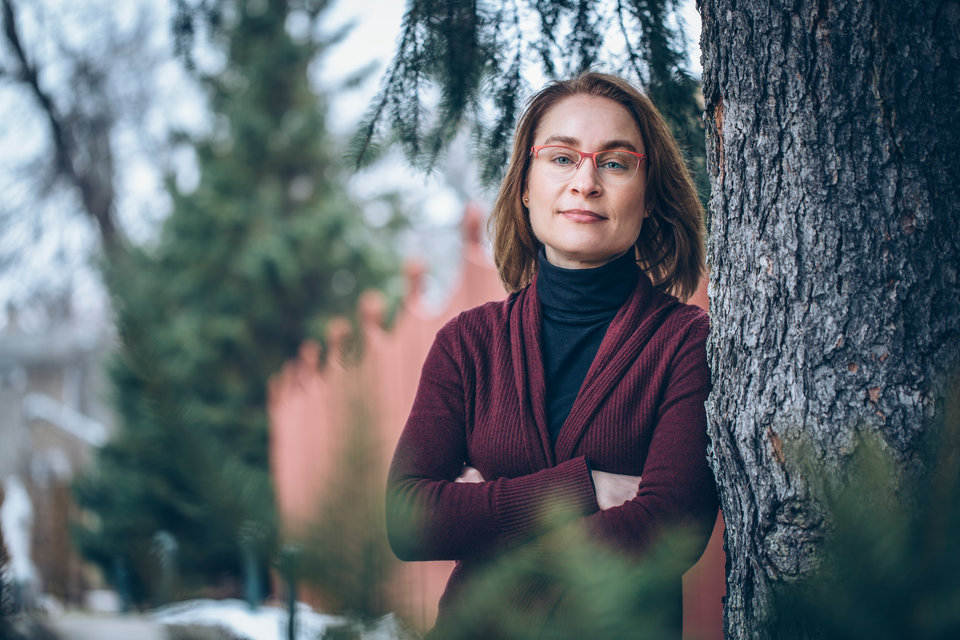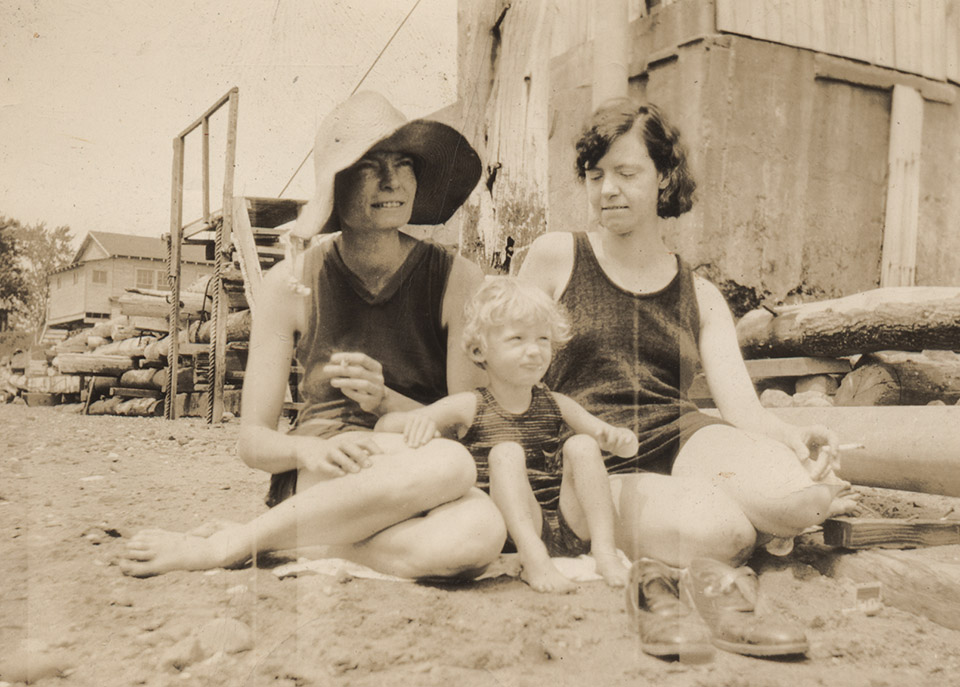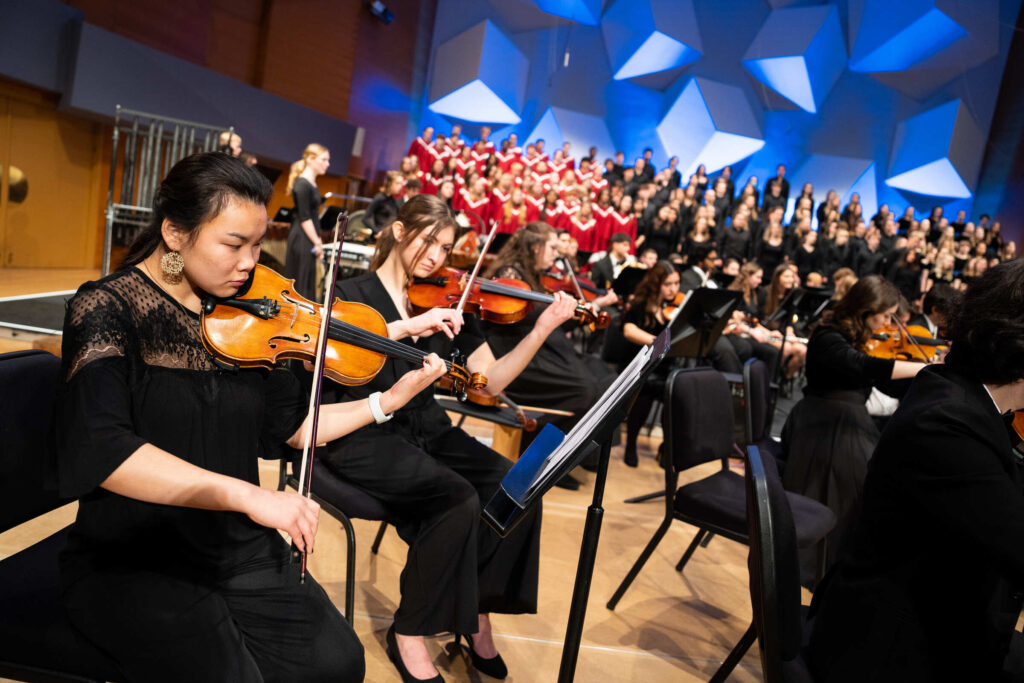Most weekdays last summer Grant Schmura and David Houserman left the biology lab around noon and drove to Lake Judy in Shoreview, Minn. As they slid a canoe off the dock and into the water of this shallow residential lake, their work had just begun. Before the day was done they would spend five hours gathering and tracking anywhere from 10 to 30 painted turtles (Chrysemys picta) from traps on the surface of the lake that catch turtles basking in the sun.
As senior biology majors, Schmura and Houserman are lead student researchers for “Team Turtle” in collaboration with Biology Department chair Tim Lewis, a wildlife ecologist whose research involves monitoring the turtle population at Lake Judy. Lewis believes field research is a necessary element to becoming a scientist, and he has been taking St. Thomas students into the field since 2009, when he came to the university.
“Learning science is a lot like learning a musical instrument,” Lewis said. “Somebody can talk to you about playing the French horn forever and you won’t learn how to play. You have to pick one up; you have to have somebody take you and mentor you through the process. It’s the same way in science. You need to go do it.”
Students such as Schmura and Houserman are treated like professionals in field-based research collaborations because their work is done at a professional, and often, publishable level.
“You get to experience the life of actual biologists and ecologists,” Schmura said. Houserman quickly agreed, adding, “There’s something about being out there with the organism you’re studying. In a lab you’re with your organism and you’re studying it, but you can’t see it interact the way it normally does. In field-based research, you’re playing in their ball field.”
In the College of Arts and Sciences, faculty and student collaborative research projects such as this occur in many departments. Much of the drive to foster undergraduate research comes from a faculty commitment to the St. Thomas mission statement, which calls for educating students to become “morally responsible leaders who think critically, act wisely and work skillfully to advance the common good.” As well, a commitment to student-faculty collaborative research is one of the priorities listed in the vision statement of the College of Arts and Sciences. In focusing on these commitments, some St. Thomas science professors are placing an emphasis on research that surrounds one of Minnesota’s most precious resources: water.
Studying the Results of an Oil Pipeline Burst
One of the reasons geology professor Jennifer McGuire came to St. Thomas in 2008 was the interdisciplinary nature of the environmental science program. McGuire’s research focuses on examining what happens to chemicals when they are released into the natural environment, such as in an oil spill. With her student researchers, McGuire asks questions to determine where the chemicals will flow and how fast those chemicals might get into the drinking-water supply.
“For me, it’s really easy to get excited about the importance of clean drinking water,” McGuire said. “It’s fundamental to life. I’m obviously passionate about that, and it’s pretty easy to get students thinking that [working toward] access to clean and safe drinking water is an important contribution to society.”
McGuire believes it is her duty to foster a strong student connection to the environment. “Part of it is getting over this idea that what’s good for the environment is somehow a sacrifice you have to make,” she said. “I think we have to move away from this model that the environment is something that is external, outside of us. The environment is our parking lots. The environment is our backyards. It’s where we eat, and we are part of it.”
When McGuire takes her students just west of Bemidji, Minn., to the site of a 1979 oil pipeline burst, the students have the opportunity to work with her and with professionals from all over the world.
“The students are thrilled to have this kind of opportunity,” McGuire said about the two-week, on-site stay. Here, students work with her to understand the types of chemical reactions that can happen when two separate water sources come together in an area affected with a crude oil spill. Students are able to look at points where an aquifer discharges and flows into a wetland. They test the changed chemistry of the water and help determine if there are any threats to local drinking water sources. When they are not working directly with McGuire, students are able to meet other professionals. The students’ help in the field is often in high demand, McGuire said. “It makes connections, gives them models for UST portfolios. It’s everything – connections and figuring out where your own interests lie.”
Analyzing Antibiotics in the Minnesota River
When professor Kris Wammer came to the St. Thomas Chemistry Department in 2005 she was excited to see the students’ enthusiasm in and out of the classroom. “All the work I do is involved with undergrads. That’s what I wanted to do – go to a school where I could do good, real research with undergraduate students,” Wammer said.
One of her current projects takes students off campus to Minnesota’s streams and ditches to analyze and understand what antibiotics are present in the water, and where they come from. A typical day in the field for Wammer’s students involves everything from going inside water treatment plants to leaning over the edge of a boat landing or standing in a freezing cold stream to collect water samples. Over the past few summers, Wammer and her students have found clear sources of both antibiotics and antibiotic-resistant genes affecting the Minnesota River. Because of these findings, next summer Wammer and her students will start examining drinking-water sources in the Mississippi River to determine whether there is a potential human health threat from similar antibiotics and antibiotic-resistant genes.
Wammer describes working with undergraduate researchers as not just “a professor-student thing.” Of her experience working with chemistry majors and environmental science majors, Wammer said, “When we’re out slopping in the mud, you get to really know each other.”
Determining the Effect of Contaminants on Turtles and Fish
Biology professor Kyle Zimmer came to St. Thomas in 2003 because he wanted to conduct research with undergraduate students. He said he had experienced working with undergraduates while getting his doctorate and he saw St. Thomas as a place that didn’t just say, “We value undergraduate research,” but actually supported it.
Zimmer’s research focuses on aquatic ecology. He and his students seek to understand how ecosystems work in shallow lakes and wetlands, and what humans are doing to influence “the smaller and shallow” water sources, such as ponds and swamps, all over Minnesota. Zimmer and his students are collaborating with other St. Thomas professors and their students: with Lewis and his team of turtle ecologists, with biology professor Dalma Martinovic-Weigelt and her fish physiology team, and with neuroscience professor Kurt Illig and his student team, which examines the health of the ecosystems in Minnesota waterways. The research explores how contaminants of watersheds might influence the biology and physiology of turtles and fish. When the water drains into Minnesota lakes and streams, contaminants in the water have the potential to make hostile impacts on the ecosystem, such as exposing fish and turtle populations to higher levels of environmental estrogens, which could result in reproductive changes. The end goal of this research collaboration is to develop strategies for reducing the effects of contaminants.
Zimmer believes that this research exemplifies the St. Thomas mission to educate students to work for the common good. “I personally feel that [when we] identify problems in the environment [and] try to come up with ways to manage and alleviate that, we make advances for the common good,” Zimmer said.
Connecting With the Community
Undergraduate research allows St. Thomas science programs to be more than an “ivory tower of learning,” Zimmer said. Each summer his students drive to outstate Minnesota in search of what most people would call a slough, and drag canoes out of the cattails and into the water. For the next eight hours they combat heat and everpresent mosquitoes, collecting samples and on occasion, answering questions from local farmers.
“A lot of times (students) will be standing by the side of the road, getting ready to push the boat out onto the lake and the farmer across the street will stop,” Zimmer said. “They get a chance to explain what they’re doing.”
“It’s really interesting running into the farmers around our lakes and having them ask us why we’re out there,” said Rachel Rockwell ’12, who has worked with Zimmer. Senior Christine Buelt agreed, saying that collecting water samples connects her to the research and the community affected by her findings. “We all take a personal interest [in the research] because we’ve been to these places,” Buelt said.
Buelt is interested in studying the intersection of ecology and environmental science as it is concerned with public health, and she hopes to go to graduate school. Rockwell plans to apply to pharmacy school. Both agree that they fell in love with research because of their fieldwork and community interactions. Of her project on the effect of bugs on the decomposition of plants in shallow lakes, Rockwell, said, “It was a really stinky job, but fun.”
Because their field research is current and practical, the students’ and professors’ main goal is to publish their research and get the information out to the public.
Research led by biology professor Dalma Martinovic-Weigelt takes her students to waste-water treatment plants in Minnesota. This research is part of a project sparked by a call from the Minnesota legislature to determine the effectiveness of waste-water treatment plants.
“Probably the most beautiful part about something like this is that your data is actually published and is part of a government report,” Martinovic-Weigelt said. “Those types of activities really grow that liberal arts student we hope to grow.”
Student researchers also grow when they are able to present their research at national and international conferences. Eight of Zimmer’s students attended the 2012 annual meeting of the Ecological Society of America in Portland, Ore. Two of his other students attended the 2012 annual meeting of the Association for the Sciences of Limnology and Oceanography in Lake Biwa, Japan.
Gaining More Than a Bullet Point on a Résumé
Undergraduate students are driven to field-based research projects for many reasons. Summer or year-round undergraduate research may appeal to many students applying to graduate or medical school. That extra bullet point on a résumé or project in the portfolio can do a lot for students, sometimes even landing them a spot in a graduate program. But talk to any of the St. Thomas students or faculty involved, and it becomes apparent that a student needs more than a desire to fill a résumé to become an undergraduate researcher.
Grant Schmura said his spot on “Team Turtle” was achieved by “annoying” his professor, Tim Lewis, on a regular basis. “There are so many other students who will do the same thing as you,” Schmura said. “You have to single yourself out. Always ask questions; that’s a big thing.”
Lewis looks for three things in student researchers: how smart they are, and how hard working and reliable they are. “Frankly the world is run by the hard-working people, and if they’re hard working and smart, it’s a killer combination,” Lewis said. “Brilliance never hurts, but brilliance alone is worthless.”
Lewis believes that research will benefit all students, regardless of what they plan to do after graduation. He lists problem solving as the most important skill a student gains in doing research because it is the first thing “everybody in the world” is looking for in an employee.
Schmura agrees. “If you don’t know what the answer is going to be, you have to figure it out yourself,” he said. “You leave school [and go] into the real world where there are no clear-cut answers.”
McGuire believes students transform into scientists when they begin to ask questions on their own. “[Then] everything is really curiosity driven,” she said. She also notes how lucky she is as a researcher to have a constant connection to the energy of the next generation of scientists.
Challenging the Next Generation
In the College of Arts and Sciences, there is no shortage of professor or student enthusiasm for going out and doing field-based research. Zimmer believes that by methodically “plowing through” the course material required to fully grasp the field-based research, students become independent thinkers and are transformed into young scientists.
“I tell students the goal for all faculty is not to produce people that are as good of scientists as we are. Because if we do that, then society is just status quo,” Zimmer said. “Our goal is to have them leave St. Thomas far better prepared, far more knowledgeable, far better citizens than [we] were at that age – to keep moving forward.”
Back out on Lake Judy, Lewis’ student Schmura and a few undergraduates moved forward in their research as they returned from checking the turtle basking traps. The researchers shed their life jackets, stowed their canoes and began examining the day’s turtle haul. After weighing, measuring and determining the sex of each turtle, Schmura attached a pit tag (used for tracking) to the turtle’s shell before returning it to the water.
Now it’s the turtle’s job to swim and the students’ job to dive back into their research.
Read more from CAS Spotlight.
